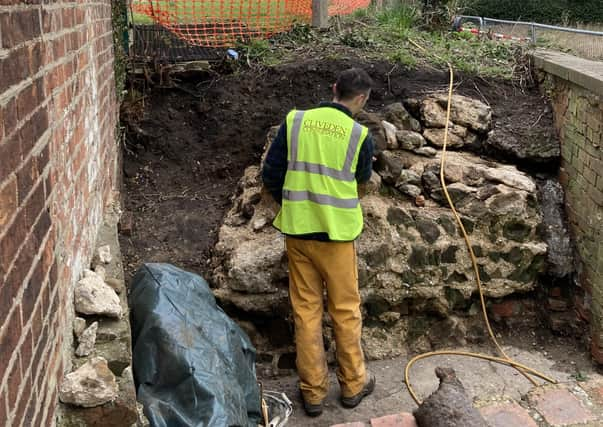Work finally starts to save Horncastle Roman Wall


The wall is the best preserved standing Roman ruins in the county outside of Lincoln, and is over 1,700 years old but has been on Historic England’s Heritage at Risk List since the first list was compiled in 1998.
Dr Ian Marshman, Chairman of Horncastle History & Heritage Society said: “It is a momentous achievement to reach this point, after hundreds of hours of volunteer work, seeking advice and permissions from all the relevant experts, writing bids and fundraising.
Advertisement
Hide AdAdvertisement
Hide Ad“I’ve been involved with the project for six years, but I would like to pay tribute to Sheila Jonkers and Mary Silverton who have been working to save the wall for almost a decade.
“We also owe a huge debt to the volunteers at Horncastle Community Centre where the wall is located, who have managed to maintain momentum whilst still also keeping a vital community facility running.”
The work is anticipated to take 13 weeks, and is being carried out by award-winning specialist conservators from Cliveden Conservation.
The team are experts in the repair of historic stonework, with experience repairing some of the most important Roman remains in the country, including the
city walls in London and the Roman baths in Bath.
Advertisement
Hide AdAdvertisement
Hide AdThe volunteers have asked people who might be curious to see what’s going on to please remember social distancing and lockdown regulations at this time.
Photos and videos will be shared on the Society’s social media so it will still be possible to see what is happening as the work takes place,
without needing to leave home.
David Dean, Chairman of Horncastle & District Community Association who run the Community Centre said: “We’re delighted that work has started as not only will it help protect part of our town’s history, the repairs will also help secure the future of the community centre, which is built directly on to part of the Roman wall.
“We will also be making some improvements to our garden, which together with the repaired Roman wall will really improve this green space for everyone using and hiring the hall.”
Advertisement
Hide AdAdvertisement
Hide AdThe work will be overseen by Lincolnshire-based chartered building surveyor Dr David Watt, who also has particular expertise in the repair of standing Roman ruins. Specialists in ecology and historic mortars, geology and archaeology have also been involved.
Eilis Scott, Acting Director for The Midlands at Historic England said: “The Roman Wall in Horncastle is a truly remarkable survival and we’re delighted that this special site is being repaired.
“Historic England has been happy to support this project, and provide both specialist technical advice and grant funding to ensure this amazing link with Roman history is conserved for future generations.”
In addition to support from Historic England, the repairs have been made possible thanks to funding from the Pilgrim Trust, Leche Trust, Tesco’s Bags of Help, Horncastle Town Council, ELDC Councillors’ Community Grants, and Medlock Charitable Trust, Michael Cornish Charitable Trust, Manor House Road School Trust, as well as over 100 donations from local people and groups.
Advertisement
Hide AdAdvertisement
Hide Ad•The Horncastle History & Heritage Society was founded in 1966 as the town’s civic society and is a registered charity with over 100 members.
Volunteers maintain a town archive and history displays at the Joseph Banks Centre, run popular talks, comment on planning applications and carry out projects to enhance the town.